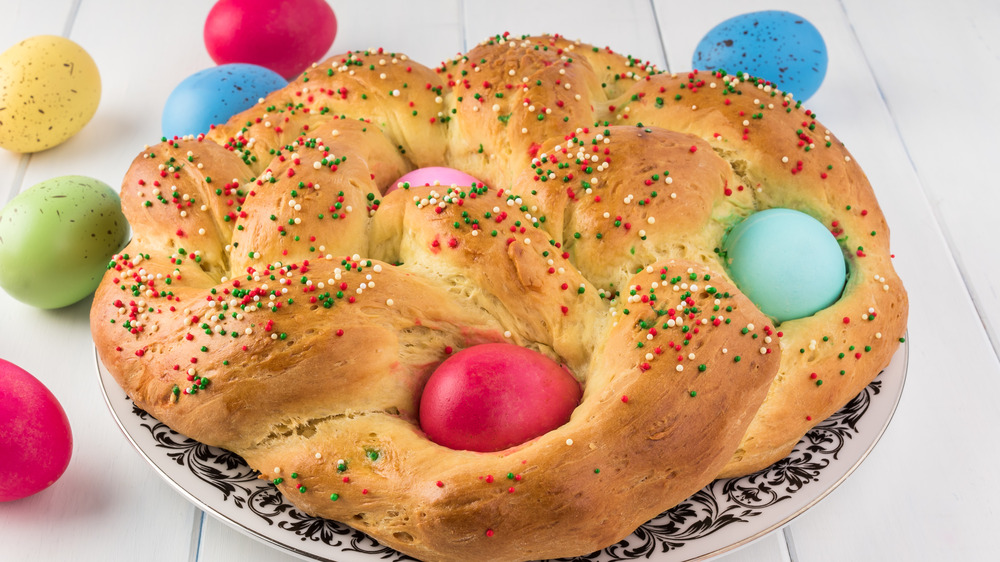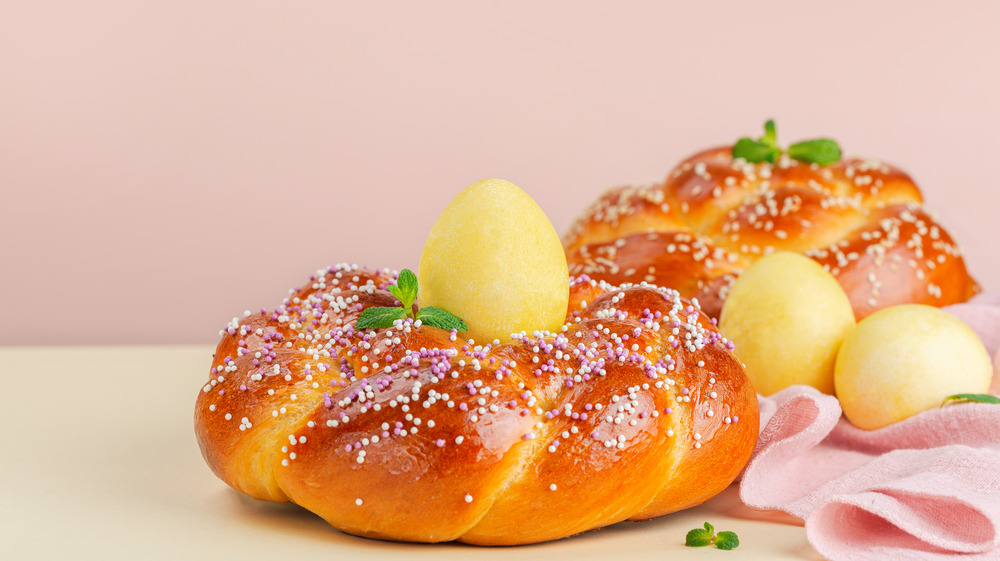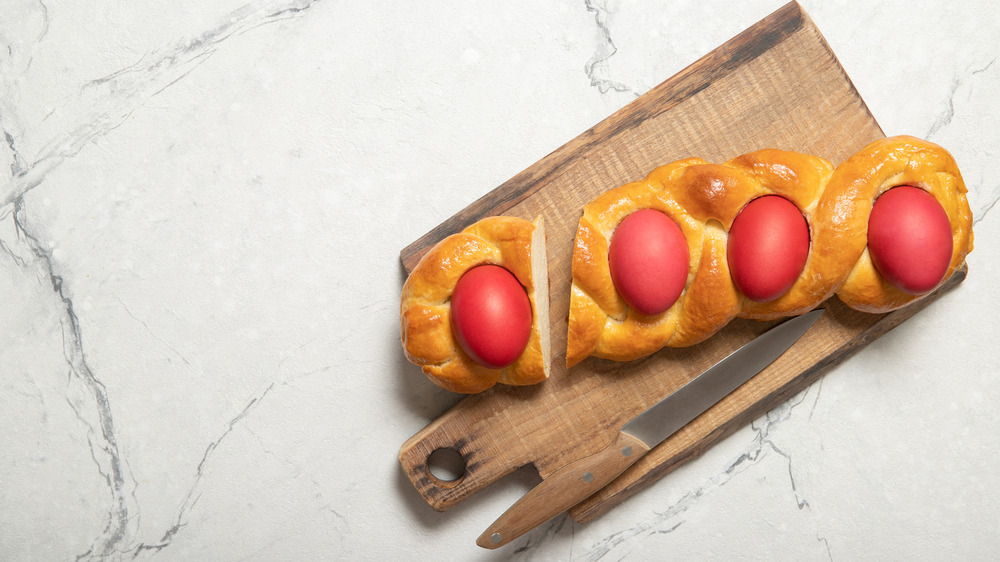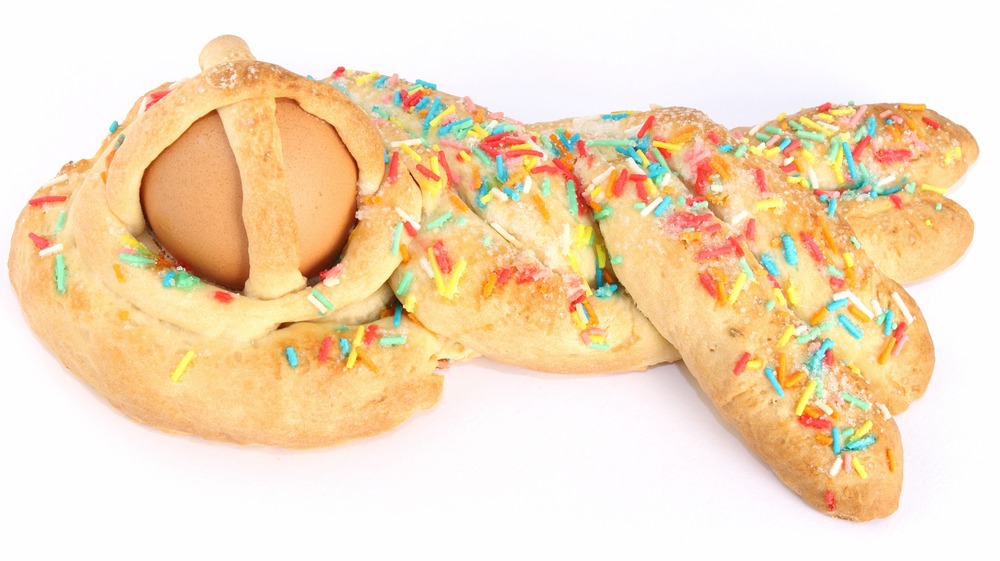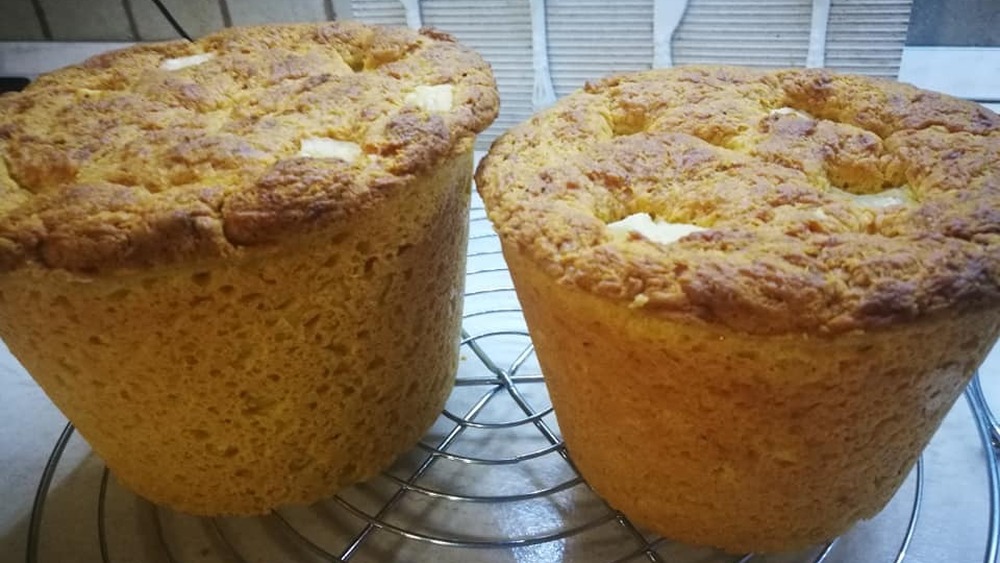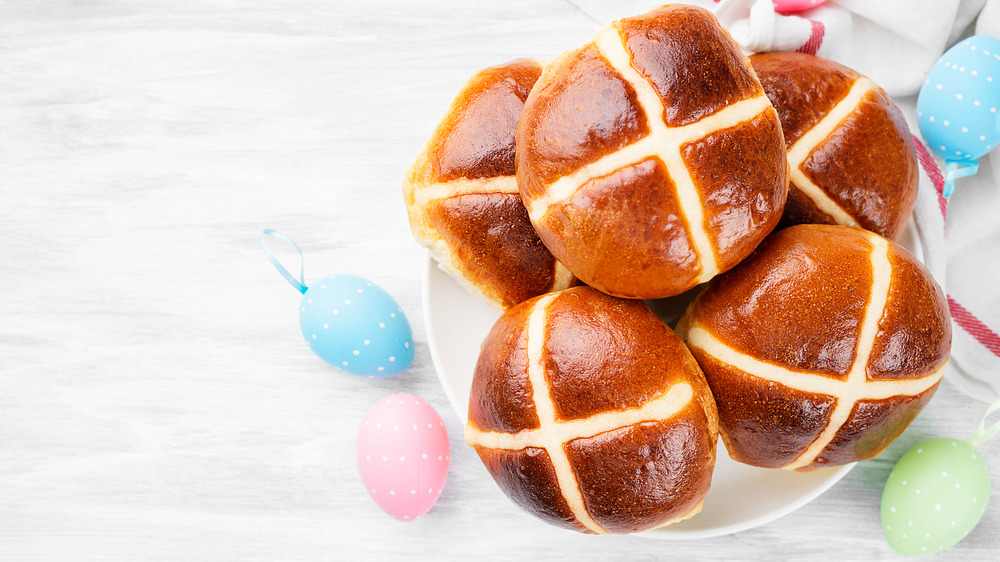What You Didn't Know About Italian Easter Bread
At Eastertime, everyone's fancy lightly turns to thoughts of springtime treats. Yes, there's the Sunday dinner with lamb, ham, or even spam (at least for this one musubi-loving Redditor), but for most of us, our favorite part of the festivities is all the sweet stuff. Chocolate bunnies are de rigueur, of course, and jelly beans are...well, they're unexciting but unavoidable, kind of like conversation hearts on Valentine's Day and candy corn on Halloween. There are Easter treats galore shaped like baby lambs, little chicks, and, of course, weird sugar blobs purporting to be chicks or bunnies or possibly amoebas (yes, we're talking about Peeps).
Yet another Easter must-have is, oddly enough, hard-boiled eggs, ones that have been decorated with varying degrees of artistry but still remain plain old eggs inside the shells. Just what, exactly, are we supposed to do with all this ovoid bounty? Sure, we can use them for a game of hide-and-seek (hoping, all the while, that none of them remain hidden until they start to stink), but what would be even better would be to do as the Romans do and bake them into an Italian Easter egg bread.
The history of Italian Easter bread
Oregon Live relates one legend about Italian Easter bread that dates a possible prototype to 6th-century Lombardy, now a part of northern Italy. Another story also cites a Lombardian origin but at a later (12th century) date. While neither bread backstory mentions anything about colored eggs, Jovina Cooks Italian says the tradition of decorating eggs in Italy may go back to the 9th century. By the 12th century, these painted eggs were taken to the church for a blessing in a ritual that went by the name of benedictio ovorum. (This translates, quite literally, to "blessing of the eggs.") These sanctified eggs were then distributed to servants and children, perhaps because they were seen as the ones most in need of a blessing.
As to that magic moment when colored eggs met bread, no-one seems to have an exact date for this or even an approximate one. The Seattle Sephardic Network, however, puts forth the idea that boiled eggs baked into bread may have originated with Ottoman Empire Sephardic Jews, and the Jewish Virtual Library confirms the fact that there were significant Sephardic communities in northern Italy by the 16th century.
Italian Easter bread is chock full of symbolism
As with so many traditional holiday foods, Italian Easter bread is as rich in symbolism as it is in eggs. And speaking of those eggs, Rick Zullo of Rick's Rome says that these serve a dual purpose. Of course, there are the standard universal metaphors pre-dating Christianity: eggs as new life, growth, rebirth, spring, and the whole circle (or ovoid) of life thing. In the Christian tradition, however, there's also the egg as a stand-in for Christ's empty tomb once he rose again and ascended into heaven.
As for the bread, its symbolic value is determined by the shape it takes. An Italian in My Kitchen says that the round, wreath-shaped breads are actually meant to represent the crown of thorns worn by the crucified Christ. When the dough is braided in three pieces, however, it has a somewhat happier meaning as it is meant to remind us of the Holy Trinity (a.k.a. God the Father, the Son, and the Holy Spirit, amen).
Italian Easter bread can comes in many different shapes
While the wreath (or crown) shape seems to be one of the most common types of Italian Easter bread, with the braided shape also being fairly widespread, different parts of Italy seem to have their own traditions about how the bread is to be formed. The Spruce Eats mentions a dove-shaped egg bread called colomba Pasquale, and if either (or both) of the Oregon Live origin stories are true, this dove bread may be the earliest form of Italian Easter bread.
Another shape that egg bread often takes is that of a little doll. The Spruce Eats says these come from Sicily and are called pupi cu l'uova, while Sensibus Deli News says doll breads are Calabrian and go by the name of cuzzupa. These cuzzopa and are given to girls, while boys receive the braided loaves. The latter source even indicates that each member of a family may receive their own specially-shaped loaf, and they included a photo of one loaf of egg bread shaped like a dove and another that resembled an egg-filled basket with a braided handle.
Some Italian Easter breads are unadorned with eggs
While the breads discussed so far are all distinguished by the hard-boiled or baked eggs that decorate them, there are several types of traditional Italian Easter breads where all the eggs go into the dough. The Spruce Eats speaks of a Tuscan savory Easter bread called pan di Ramerino where the ingredients include olive oil, walnuts, raisins, rosemary, and other spices. Cookbook author Emiko Davies writes of another Tuscan Easter bread, schiacciata di Pasqua, that she calls "Tuscany's answer to Milan's panettone" (via SBS). This is a sweet bread, flavored with citrus rind, anise seed, and a dash of the licorice-like liqueurs Sambuca or Strega.
Yet another savory bread, crescia al formaggio, is made with cheese. Italian Recipe Book says this bread is native to central Italy including the Abruzzo, Lazio, Marche, Molisse, and Umbria regions. It's cooked in a tall cylindrical pan, and was supposed to have originated with medieval nuns who baked it during Holy Week using 40 eggs to represent the 40 days of Lent. The recipe they provide calls for a more manageable 4 eggs along with Pecorino, Parmesan, and either Emmental, Gruyère or Swiss cheese.
The Italians aren't the only ones baking eggy Easter breads
While the Italian Easter breads are among the most eye-catching of traditional Easter treats, they do have their counterparts in other cultures. Apart from the symbolic reasons, NPR notes that one reason for the abundance of eggs in springtime baked goods is the rather mundane fact that hens don't lay much in winter, but they get back to business once the days get longer and warmer. The Easter breads most similar in appearance to the Italian egg breads come from neighboring Mediterranean countries, perhaps due to that Sephardic influence. In Greece, the egg bread is called tsoureki, and according to the Greek Reporter, the red-dyed eggs on top are meant to symbolize the blood of Christ. In Portugal, the egg breads are called folares, and the eggs used may or may not be dyed.
Other egg-rich breads, although they may not be decorated with this ingredient, are nevertheless an important part pf Easter celebrations across Europe. Eastern Europe has its babkas and its paskas, Russia its kulich, and even England (and by extension, the U.S.) has its egg-rich hot cross buns.
